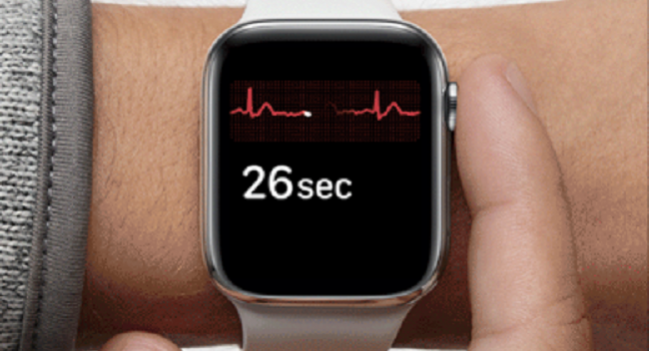Apple Watch as an ECG? Feasible, May Prove Useful in Emergencies
The ability to take an accurate multilead ECG that could diagnose MI with a wearable could have implications for emergencies.

An Apple watch can obtain a multilead ECG comparable to that of a conventional 12-lead readout, preliminary research suggests.
When compared with a conventional ECG, the Apple Watch ECG showed “identical” readouts in the standard limb leads and a “great resemblance” in the precordial leads, according to investigators.
“Considering the sales figures of Apple devices, the watches likely outnumber conventional ECG machines worldwide,” writes study author Miguel Ángel Cobos Gil, MD, PhD (Hospital Clínico San Carlos, Madrid, Spain). “The availability of a method to record an ECG with diagnostic potential anytime and anywhere could potentially revolutionize our approach to cardiac emergencies.”
Published online this week ahead of print in the Annals of Internal Medicine, Cobos Gil explains the proper methodology to either self-record or to record someone else’s standard and precordial leads for an optimal ECG. With the Apple watch series 4 or 5 in its normal wrist position and touching its digital crown with a finger, the device can record a single-lead ECG capable of rhythm analysis. Moving it to any place on the leg can enable the capture of leads II and III, and placing it on the chest can record leads similar to V1 to V6, called CR1 to CR6. These additional leads can enable a readout in which to diagnose MI or LV hypertrophy.
“This method could be extremely useful when you have an emergency and you don’t have a conventional ECG available,” Cobos Gil told TCTMD in an email, giving the examples of an international flight or a rural setting.
However, the findings described in the paper using these methods should be “interpreted with caution—a broad range of clinical studies is needed to determine the role of such devices in the diagnosis and follow-up of patients with known or suspected heart disease,” he writes. Next up will be an analysis looking at the Apple watch versus conventional ECG in 40 cardiac patients called DRAW, Cobos Gil added. “In the future, the device will be linked to some program of artificial intelligence to diagnose cardiac emergencies”
What’s fascinating, said Cobos Gil, is that while the first ECG machine “weighed more than 200 kilograms and was operated by a team of four workers, nowadays you can obtain an ECG in seconds using a gadget of 30 grams!”
Potential in Emergent and Rural Settings
Janet Han, MD (VA Greater Los Angeles Healthcare System, UCLA, Los Angeles, CA), who was not involved in the study, said the feasibility of doing these kind of measurements was originally outlined in the Apple Watch patent back in 2016, but this is the first time, to her knowledge, that it has been studied.
It’s likely that someone has used an Apple Watch in this manner to take a multilead ECG in a clinic before, Han added, but having this published establishes feasibility. “Now they've proven that it can be done, and it can be done with accuracy as well, as long as you know what you're doing.”
Proper training is going to be the biggest hurdle to obtaining correct ECG readings with an Apple watch, which “won’t necessarily be entirely intuitive,” she said. “A standard 12-lead is pretty easy to train someone to do because you just sort of stick the stickers on the body in the proper positions. Using the Apple watch, it's nice that it's portable, but you have to make sure that people know what they're doing to get the proper leads. So training is going to be paramount.”
While Han agreed this feasibility could have implications for emergency situations, “I'm interested in looking at the applicability of stuff like this in rural outreach settings,” she said. If a doctor practicing in a rural setting has his or her own Apple Watch, “they could potentially do this for their patients too. It's all about finding those pockets of need that maybe not everyone can afford one, but if there's one person that has one, they could probably do a lot of good.”
Photo Credit: Apple.com
Yael L. Maxwell is Senior Medical Journalist for TCTMD and Section Editor of TCTMD's Fellows Forum. She served as the inaugural…
Read Full BioSources
Cobos Gil MA. Standard and precordial leads obtained with an Apple Watch. Ann Intern Med. 2019;Epub ahead of print.
Disclosures
- Cobos Gil and Han report no relevant conflicts of interest.


Comments